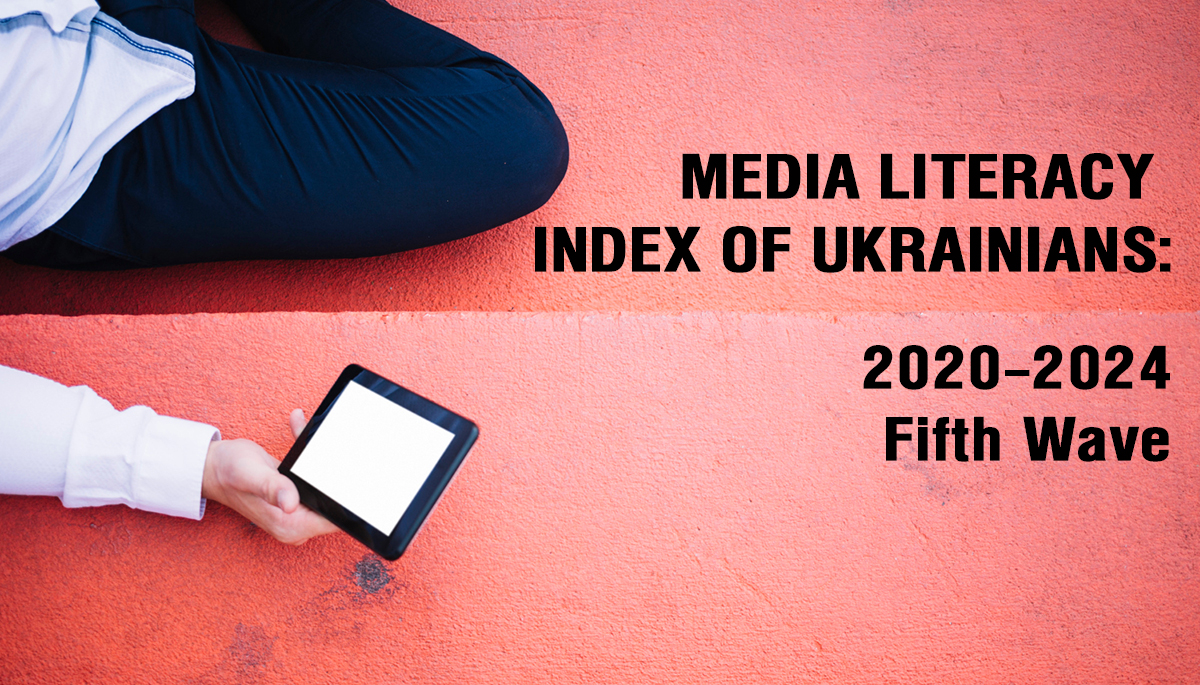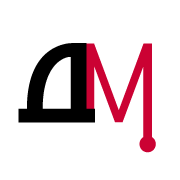Українською читайте тут.
The Detector Media NGO conducted a quantitative study to determine the Media Literacy Index of Ukrainians—that is, the level of their ability to consciously perceive and critically interpret information and to use various types of media. You can view the results of previous waves of the study here (for 2020), here (for 2021), here (for 2022), and here (for 2023).
The model of the Media Literacy Index is based on Len Masterman's concept and the findings of the qualitative stage of the study “Media Consumption Practices of Ukrainians: Conceptual Development of the Audience’s Media Literacy Index,” commissioned by Detector Media (January 2020). The refined media competence model includes five categories and 41 indicators. Indicators marked in blue italics in the presentation were added in 2024.
Purpose of the study: to calculate the Media Literacy Index of Ukrainians and identify its dynamics compared to previous years.
You can download the PDF version of the report here.
Key Findings of the Study
MEDIA LITERACY INDEX DYNAMICS: 2020–2024
The overall Media Literacy Index level has significantly changed since the start of the full-scale war. From 2021 to 2022, the share of the audience with above-average media literacy increased by 26% (from 55% to 81%).
Accordingly, the proportion of Ukrainians with low or below-average media competence decreased (from 45% to 29%).
Throughout all three years of the war, the index level has remained high and has not dropped to pre-war levels. The decline in the share of the audience with a high level of media literacy in 2024 compared to 2022 (from 31% to 7%) is primarily due to adjustments in the calculation methodology (as explained in the report below), as well as certain adaptations to the current media landscape, accumulated experience in content verification, and emotional fatigue from difficult information related to the war and developments on the front line. For example, the results of the fifth wave of the study show a decrease in the average number of sources Ukrainians consult for socio-political news, less certainty about the media and experts they trust, and a reduction in the number of people verifying the credibility of content.
At the same time, the overall Media Literacy Index has changed significantly over the past year: the share of the audience with an above-average level decreased from 76% to 72%. This is due to methodology adjustments, specifically the expansion of the digital literacy subindex with new indicators reflecting perception and use of artificial intelligence.
The subindex of understanding the role of media in society has increased: the share of the audience with above-average performance grew from 68% to 81%. The nature of media use and the sensitivity of Ukrainians to distorted content have not changed over the past year.
The share of the audience with high or above-average digital competence declined from 55% to 48% (2023 vs. 2024).
A high level of media literacy among young people aged 18–35 is predictable (due to high digital competence), while low levels are observed among the older age group (56–65).
The lower the level of education, the lower the media literacy. Among those with only secondary education, 41% have low or below-average media literacy, while among those with full or partial higher education, this share is only 16%.
Significant differences in media literacy levels are observed between people of different financial statuses. The higher the level of well-being, the higher the index. Among those who can only afford food (low level of well-being), 44% have low or below-average media literacy. Meanwhile, among respondents who can afford everything they need and save money (above-average well-being), this share is just 19%.
Residents of large cities demonstrate higher index values than rural residents.
The overall shift in understanding media influence among the Ukrainian audience over the past two years can be explained by the dominant theme of media content—emotionally difficult messages related to the war. The share of those who acknowledge the media’s impact on their emotional state increased by 12% compared to 2021 (from 35% to 47%). As traditional media topics have been almost entirely displaced by war-related content, consumers report a diminished influence of media on attitudes toward public figures, political preferences, and even assessments of the socio-political situation.
PERCEPTIONS OF THE MEDIA INDUSTRY AND THE UKRAINIAN MEDIA LANDSCAPE
There have been no significant changes over the past year in the public’s understanding of the role of media in society. However, a noticeable trend is the growing share of the audience who believe that media should serve as a platform for dialogue between the state and society, rising from 29% to 37% over the past three years.
The majority of the audience (70%) believes that the primary mission of the media is to inform citizens about socially important events.
Every second Ukrainian (51%) believes that the media in Ukraine operate in the interests of the government, while 40% think the media serve their own interests. Another quarter of the audience (24%) is convinced that media reflect the interests of their owners and investors.
The largest portion of the audience (34%) believes that there is no official censorship in Ukraine, but it exists in a hidden form; 17% believe there is no censorship either officially or in practice. Meanwhile, 42% report the presence of censorship in Ukrainian media. Three out of four Ukrainians (75%) believe the state sets the rules that regulate media operations.
The share of those who have a positive view of the telethon format has dropped over two years—from 45% in 2022 to 17% in 2024. 77% say that due to the lack of diverse perspectives presented in the telethon, they seek information from other sources.
CHANGES IN MEDIA PREFERENCES
Every second Ukrainian (44%) supports criticism of the government in the media. Among this group, men and individuals from older age groups prevail. This view is also more often supported by those with higher educational attainment. Meanwhile, 17% do not support public criticism of the state.
The share of the audience confident that public service media exist in Ukraine is 58%, an increase from 54% in 2023. One in five (21%) believes that there are no independent broadcasters in the country, while the same share (22%) could not provide a definitive answer.
An overwhelming majority (74%) emphasize the importance of public service media, stating that they serve the interests of society rather than private owners (51%); cover topics not of interest to commercial media—such as social issues, culture, and science (10%); and are less likely to engage in manipulation (13%).
The share of the audience that paid for access to at least one type of content (video, audio, or online publications) over the past year is 30%. Specifically, 25% paid for video content (Netflix, MEGOGO, other streaming platforms, YouTube Premium, etc.); 18% for audio content (Spotify, Apple Music, YouTube Music, etc.); and 3% purchased access to online media (Forbes, NV [New Voice]). Additionally, 17% made charitable contributions in support of media outlets.
Compared to 2023, in 2024 the number of people consuming socio-political content on social media increased (from 62% to 70%), as well as on messaging apps (from 55% to 62%). There was also a rise in the number of individuals who receive socio-political news through communication with friends, neighbors, colleagues, and relatives.
Only a quarter of Ukrainians (26%) watch the national telethon "United News," marking a noticeable decline compared to previous years (41% in 2022 and 31% in 2023).
INTERNET USAGE AND DIGITAL COMPETENCE
Only 5% of Ukrainians do not use the internet. 91% are intensive internet users, accessing it daily or almost daily. This proportion has remained unchanged over the past year.
The primary motivations for internet use continue to be searching for necessary information (76%) and staying informed with news (62%). The share of users seeking entertainment and educational content (videos, films, podcasts) and engaging in online shopping has increased, reaching pre-war levels. In 2024, 58% watch videos and films online, and 39% make purchases via the internet, compared to 46% and 27% respectively in 2022.
The most popular social media platforms for accessing socio-political news among Ukrainians are Telegram and YouTube, used by 60% and 37% of the audience, respectively. Only 16% do not use Telegram, and 11% do not use YouTube. For educational and informative content, YouTube and Facebook are the most frequented platforms, with 47% and 28% of users, respectively. For communication, 83% prefer Viber, 57% use Telegram, and 40% use Facebook.
28% of the audience utilize artificial intelligence (AI): 14% incorporate it into their work; 12% use it for educational purposes; and 13% for other activities.
72% do not use AI. Among them, 37% cite no need for it; 13% are unsure how to use it; 10% lack trust in AI systems; and 11% have never heard of them.
MEDIA LITERACY: TRUST IN MEDIA AND SENSITIVITY TO DISTORTED CONTENT
The significance of disinformation as a problem is emphasized by 62% of the audience (compared to 64% in 2023, indicating negligible differences). 17% stated that they can always identify fake news and disregard it.
A high level of sensitivity to distorted content among Ukrainians can be observed. The audience is becoming more competent in detecting fake information, a trend that has persisted over the past three years since the onset of the full-scale war. Only 18% rely on intuition to determine the trustworthiness of a message.
The proportion of Ukrainians who detect disinformation by seeking source references in materials is 43% (up from 37% in 2023). 33% look for video or photo evidence (compared to 30% in 2023), and 30% rely on the good reputation of the author (up from 28% in 2023).
The issue of media manipulation is relevant for more than half of the Ukrainian audience (60%); 16% consider it irrelevant because they can identify such content; 15% have heard about media manipulation for the first time, and 3% were undecided. There have been no significant changes over the past year.
47% suspect manipulation when only one side of an event is presented; 43% consider incomplete or inaccurate information as a significant indicator. For 39%, the absence of source references raises suspicion about the authors' intent to manipulate the audience's perception. Only 22% identify manipulative messages intuitively.
According to the audience, media content is most often distorted in the interests of politicians and political forces to create a positive image (66%), as well as by the state to promote certain ideologies or interests (32%). Over the past year, the share of those who believe that oligarchs, influential groups, and media owners distort information to increase their audience has decreased (from 41% to 32% and from 26% to 15%, respectively).
The issue of paid content in the media remains relevant for more than half of the audience—54% (compared to 57% in 2023); 19% state that they can identify such content and disregard it (17% in 2023). 16% consider it irrelevant as they have heard about it for the first time.
49% suspect paid content when only positive or negative aspects of a person, group, or product are highlighted; for 47%, a significant indicator is that the material may contribute to the recognition of a person, organization, or product. 28% of the audience identify paid content intuitively. Respondents also pay attention to the presence of evaluations, positive or negative (16%).
Most Ukrainians are skeptical of the media—trusting them only partially.
Over the past year, there has been a noticeable trend of declining trust in various media outlets, from television to messengers. At the same time, the number of consumers who partially trust content from different sources is increasing.
Study Design
Methodology: Quantitative research; face-to-face interviews conducted using tablets and a standardized questionnaire (CAPI).
Geography: National-level study. The research was not conducted in the temporarily occupied territories of Donetsk, Luhansk, Zaporizhzhia, Kherson regions, and the Autonomous Republic of Crimea.
Sample size: 1,200 respondents.
Target audience: Adult population of Ukraine (aged 18–65).
Sampling type: Representative by age, gender, settlement size, and region.
Fieldwork period: January 15–29, 2024, conducted by the company “New Image Marketing Group.”
The report, based on data from the quantitative study carried out by the research agency “New Image Marketing Group” on behalf of the NGO “Detector Media,” was prepared by Marta Naumova, PhD in Sociology.



